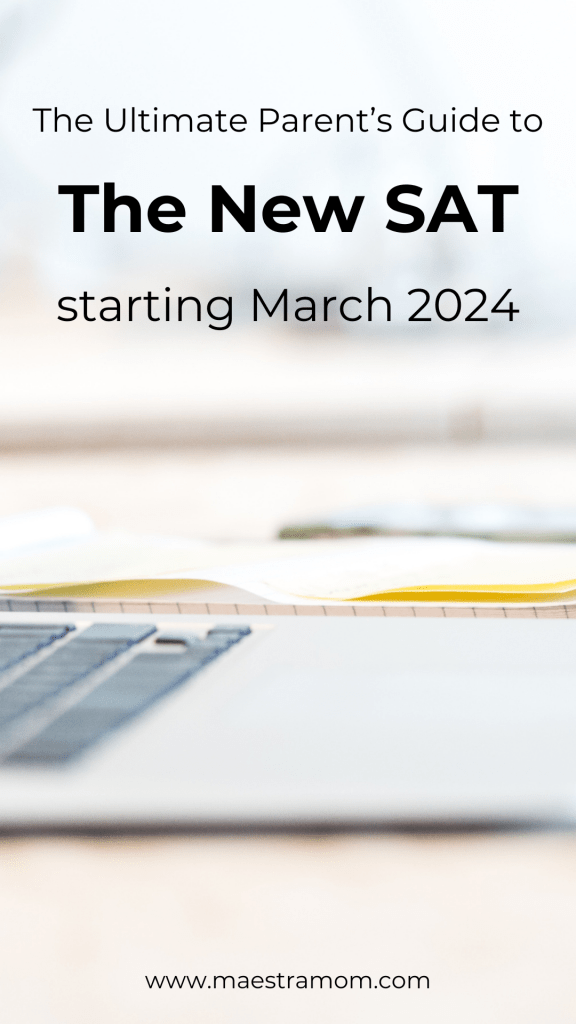By Tim Levin
Put your pencils down; a major transformation is on the horizon for an iconic rite of passage for college hopefuls since its inception in 1926. The SAT will soon be shedding its paper skin to embrace the digital age. The College Board—the body that governs the SAT—has already begun rolling out alterations to transform the test from its dated paper format to a dynamic and streamlined online experience.
This pivot to the virtual realm is set to usher in a new era of efficiency and accessibility, but will, without a doubt, be accompanied by a new set of challenges for students as well. With its U.S. debut scheduled for March 2024, the now digital SAT will arrive with an all-new layout and structure that is designed to modernize the test-taking process.
What, then, do parents need to know to prepare their students for such drastic changes to a familiar, time-tested process? Below is an overview of the five most essential changes made to the new SAT.
1. A More Adaptive, Personalized Test
The most fundamental evolution of the SAT is undoubtedly its adaptation to each student’s capabilities. Traditional standardized tests, including the previous version of the SAT, have long been criticized for their rigid, one-size-fits-all structure. The revamped online format, however, adjusts the difficulty of future questions based on a student’s performance on earlier questions.
The initial module of each section presents a range of questions that assess the student’s competency. How well a student performs in this segment determines the level of complexity of the second segment; once questions in the second segment are adjusted, the score cap of the entire section is adjusted as well.
A stronger performance in the first stage will unlock more challenging questions, potentially leading to a higher overall score. It is important to note, however, that while the format is changing, the new version is just as challenging as the traditional SAT – it simply offers a different approach to measuring a student’s abilities.
>>> It Turns Out Homeschooling is Unique – Here’s Why
2. Fewer Questions, More Weight
In addition to its new adaptive capabilities, the newly designed SAT has also decreased the total number of questions. Under this new structure, each question becomes more impactful, increasing the premium on accuracy and strategic answering.
The test is no longer about answering as many questions as possible. Instead, it’s a steep and demanding curve where each question holds the potential to significantly influence a student’s overall score.
This shift in the SAT’s structure calls for a change in preparation tactics. Students will now need to emphasize understanding concepts thoroughly, mastering problem-solving techniques, and honing precision in their responses, rather than aiming to complete a large volume of questions.

Studies show that homeschooled students’ mean test score on the SAT outperforms private and public school students. Want to learn how to get started homeschooling today? Grab a copy of Heading into Homeschool and find out how easy it can be!
3. A New Opportunity to Manage Time Wisely
Along with trimming the number of questions, the College Board has also cut down the amount of time students have to take the digital SAT. The previous version of the SAT clocked in at three hours, but it’s now set to occupy a notably shorter timeframe of two hours and fifteen minutes.
Like its paper predecessor, the digital SAT is not only testing students’ knowledge and problem-solving skills but also their ability to effectively manage their time under pressure. In a race against the clock, every minute—and indeed every second—is of the utmost importance.
While managing time is tough when students take paper practice tests, that’s not the case for digital practice tests, where students receive immediate feedback on the amount of time they spend on each question. This helps them develop sound time management skills needed to turn in their top performance.
4. Navigating the Digital Terrain is Crucial for Success
As the SAT shifts to the online format, students must master the new testing environment. More than just understanding the subject matter, the revised digital SAT requires technological fluency as an essential part of achieving success.
In this new setting, it’s not enough to merely understand mathematical formulas or have a robust vocabulary. Proficiency in using online tools, such as a digital calculator, becomes vital. During the math portion of the digital SAT, for instance, students will now have access to the Desmos online graphing calculator throughout the entire section.

This change to an online medium for standardized testing redefines what it means to be prepared for the SAT. It introduces another level of complexity to the test, requiring students to feel comfortable with digital interfaces and calculation tools, honing their skills in using technology to solve complex problems more efficiently.
5. The Return of Vocabulary Questions
While the SAT’s newest evolution is cutting-edge for the education landscape, the exam catches a glimpse of the past with the reintroduction of vocabulary-focused questions. Where once the SAT had moved away from these questions in favor of context-based reading comprehension, the redesigned exam includes a renewed focus on language proficiency.
The return of vocabulary questions emphasizes the need for students to possess not just a passive understanding of language, but an active, constructive use of it. Students will need to engage deeply with language, mastering the nuances of a wide range of words and their applications.
>>> 8 Benefits of Homeschooling
Bottom Line
As the SAT transitions from a traditional paper-and-pencil format to a digital platform, it is introducing a series of significant changes that will reinvent the way students—and parents—navigate standardized testing. From an adaptive and streamlined system to the introduction of new digital tools, the SAT is catching up with the times. And so long as the SAT remains an indispensable step in the student’s educational journey, parents will need to catch up, too.
Tim Levin is the Founder and CEO of Bespoke Education, which for more than 20 years has provided the highest quality tutoring, test preparation, and academic support to students from elementary through graduate school. He previously worked at Kaplan Test Prep and graduated from Yale College. More info at www.bespokeeducation.com.

